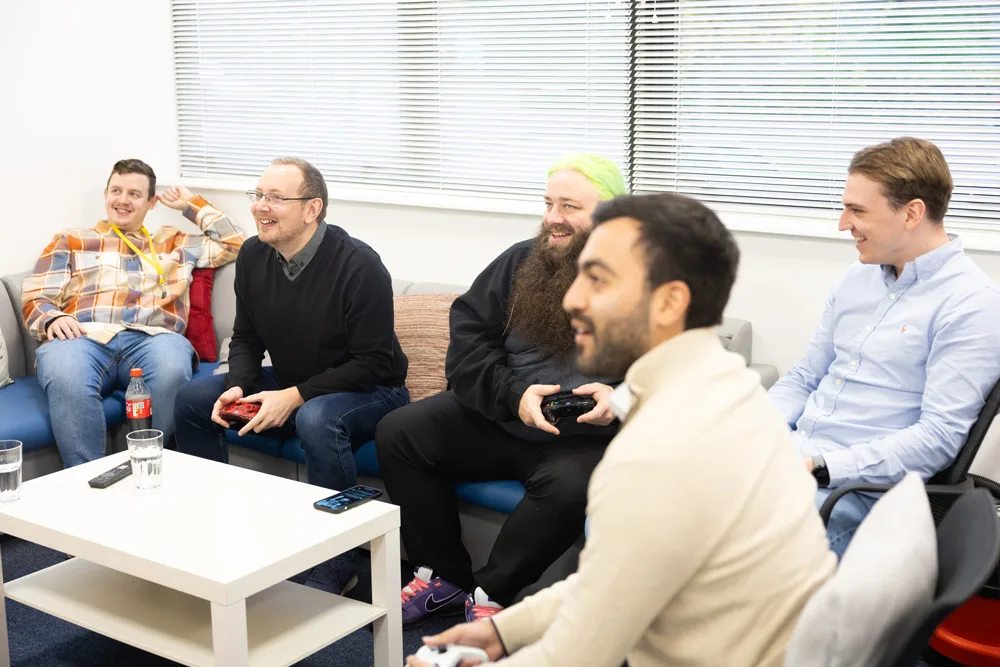Our Managing Director, David Smetana, was asked to share his expertise on the
digital transformation of the financial services industry, a sector in which we have a wealth of knowledge and experience.
As we’ve been looking recently at the impact of legal technology on law firms, we decided to combine our findings into an article on digital transformation consulting examples in the real world, covering a range of industries and how they’ve implemented digital change.
Digital transformation consulting: 4 sectors achieving digital success
The everyday workplace once required paperclips, pencils, file cabinets, and typewriters to run smoothly. Looking up a reference wasn’t always a seamless task. Instead, it meant searching your filing cabinet for the right information, hoping it had been organised correctly.
Fast forward to the present day – we live in an era where access to our data comes from the tap of a finger.
With the implementation of digital adoption platforms, digital learning platforms, and career management systems, the employee’s capabilities have doubled, even quadrupled.
In this article, we share observations and consultation expertise from the financial, legal, recruitment and healthcare sectors as to how digital transformation is impacting their industry.
Let’s get stuck in.
1. Financial Services
David Smetana, the co-founder of
Chalkline, offers an inside look at how he is leveraging digital transformation and providing consultation to enhance financial services:
“We look after several businesses in the Financial Services sector, and some of the essential requirements from our clients are a fluid collaboration between offices, increased efficiency and emails & documents hosted in the cloud.
Our experience is that they are often using legacy technology which we replace with cutting edge Microsoft solutions. The challenges are more prominent as companies look to scale their businesses, often opening up multiple new offices only to find that the existing solutions are no longer fit for purpose. Their IT legacy infrastructure was not progressing alongside the rest of the business.
There is a definite need for a new IT strategy that can comfortably accommodate not only ambitious growth plans but can meet the highest standards of security and reliability by FCA regulations. At the very core is the ability to run a mobile workforce and scale without the downtime and enable more flexibility to be able to work from home at any time.
Our solution is to introduce them to the benefits of the full Microsoft stack, which includes Microsoft 365 and Azure. These offer businesses the potential to enable scalability and flexibility in a way that existing legacy software couldn’t. Most businesses don’t have the expertise or the time to deal with all aspects of their IT infrastructure. We can effect real results and implement these in a short space of time, dramatically improving the efficiency of businesses.” (David Smetana).
The financial services industry has shifted its focus to engaging with customers on a deeper level, adopting a more customer-centric approach. This has been done primarily through the consolidation of data into one accessible area, while improving the quality of financial apps. Data analytics is an essential tool that’s being leveraged by banks in order to understand customers better, identify business opportunities, and reduce costs.
2. Legal
The legal industry has been slower than most to adopt digital transformation. It’s risk-averse mentality comes from traditional rules, tight regulation controls and the dealing of highly sensitive client information. Yet, there’s a movement happening. With advances in cloud adoption and virtualisation, law firms now realise the potential for savings in cost and time.
Let’s have a look at an example of one such firm who was ready to take the next step in their business journey:
Uk law firm, Womble, Bond, Dickinson found that the changing legal landscape encouraged them to implement digital change. And, it has made them look to see how future technology developments could change the nature of the relationship between in-house legal functions and external providers of legal services. In relation to contract production, their use of document automation tools enables their lawyers to produce contacts and other documents through a questionnaire format. They used this automation to produce thousands of supplemental GDPR agreements on behalf of clients.
“At first, our client was sceptical. This was because we didn’t produce any agreements for almost a month and the client was understandably nervous with the deadline fast approaching, but it was during this time that we were building the automated template with the variables that the client required and organising the client information into a useable format. As soon as this was finished and approved, we were able to produce all the required agreements in seconds.” (Womble, Bond, Dickinson). With the risk-adverse nature of a law firms, it’s important for law practices to use the right technology (and get the right transformation consultation) at the right time. Some technologies might be nice to have but are complex to deliver or aren’t viable. This will make adoption more difficult and more likely to fizzle out. Therefore, it’s important to pin-point exactly how legal technology can help each individual firm.
3. Recruitment
James Lloyd-Townshend, CEO of Frank Recruitment Group, shares his experiences with digital transformation in the recruitment industry, and how it has significantly improved processes:

“As a niche IT recruitment agency, a big part of our job is to assist clients with aspects of their digital transformations.
But, like all industries, Recruitment is going through its own transformation too. For candidates, the decision to change jobs is a milestone event, so human conversation via phone calls is still really important — and we don’t think that will ever change. However, our talent acquisition strategy now begins online, where we’ve adopted an omni-channel approach. For example, social media is something we leverage because that’s where the people are. We use tools like LinkedIn Recruiter which has algorithms to help our sales team source suitable candidates for roles.
We also appreciate that the majority of active job searches now begin with smartphones, so we are currently engineering all of our brand websites to be mobile-first. After we’ve made initial contact with candidates, we often find that communicating via WhatsApp is well-received. It’s a discrete and convenient way to get in touch, and can be particularly helpful for candidates who are still at another workplace and don’t want to answer calls.
To tie everything together and get a single, 360-degree view of our customers, we’ve recently implemented a multi-million dollar CRM system. This is the biggest part of our digital transformation so far, and has streamlined everything for our consultants to make their lives easier and more productive. Phase two of this project will be to integrate more third-party apps to allow for better multi-channel communications with our customers.” (James Lloyd-Townshend)
Recruiters can use data to assess the digital footprint of a candidate. Social media is used to evaluate the candidate’s overall personality in order determine if the position is right for them. The consolidation of databases and of resumes has become a powerful tool to help speed up the hiring and recruitment process. Additionally, candidates can easily engage with the company through different platforms.
4. Healthcare
Matt Cuff, MD, Switchstance Agency, contributes his observations of the improvements being made to the healthcare sector based on his consultations with clients.

“Digitisation is moulding the way that companies and people utilise information and continues to shift dramatically. Whilst this is the case for most industries, this statement rings especially true for the healthcare sector.
Through our experience working with various clients in the healthcare industry, we have a pretty firm grasp of the direction technology is taking them and the actions that need to be taken to get there.
In our experience collecting and processing large amounts of data just isn’t going to cut it anymore, being able to combine previous disparate datasets to explore correlations and trends is needed to create powerful insights and drive innovation. ‘Big data’ is a term that has been thrown about frequently, but it is not the gathering but the use that makes the difference. We have personal experience in this area, including the combining of diagnostic and prescribing information for Diabetes, opening up entirely new, powerful insights to enable better patient care.
Mobile apps are becoming a normal sight in hospitals and GP practices, whether that is to provide a video chat experience to connect doctors and patients, improve booking and providing patients with more flexibility and control or as a mean of collecting accurate data. The availability of such apps and software also helps manage operational activity such as staff rotas and care-planning.
Even making relatively small changes such as enabling people to book GP and hospital appointments online have a large impact in terms of reducing the burden on over-stretched staff.
In a hospital setting in particular, BYOD (Bring Your Own Device) shows how technology has allowed a hindrance because of security implications become a huge benefit for doctors. What was once seen as too unsafe in a risk-averse environment has saved measurable savings in time and effort as well as improvement to the patient journey.
Maintaining an evolving service that matches the new consumer demands is no easy feat, especially in a sector as complex as healthcare — but technology is allowing them to create a new and fresh experience for patients.
As an agency that works closely with healthcare providers, we hope that technology continues to transform healthcare.” (Matt Cuff)
Telehealth is the concept of digitising the healthcare experience, which has significantly improved the healthcare experience for patients. Doctors have better access to patient data for improved quality of treatment. They also have use of better technology, which has a positive impact on the overall healthcare system. One huge example are robotics which have transformed surgery. They’ve transformed procedures that were once invasive and dangerous to be safer and quicker.
Transform with digital transformation
With digital transformation on the rise, we must continue to embrace innovation and look forward toward the future.
These digital transformation consulting examples show – on an individual level – how quickly technology is sinking its teeth across industries today. From the legal sector to finance, the digital experience across the workplace has been enhanced by digital solutions that were beyond an employee’s imagination just fifty years ago.
If you’d like you to champion digital transformation within your organisation, read our digital transformation strategy guide or get in touch with our team. [Editor’s note: This blog post has been updated with new content as of 17/09/2020]











